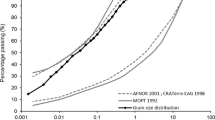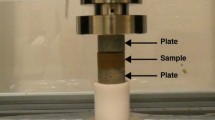Abstract
This paper investigates the mechanical behaviour of a hypercompacted unstabilized earth material manufactured by compressing a moist soil to very high pressures up to 100 MPa. The hypercompaction procedure increases material density, which in turn improves mechanical characteristics. Samples were manufactured at the scale of both small cylinders and masonry bricks. The effect of ambient humidity on the mechanical characteristics of the material was investigated at the scale of cylindrical samples, showing that both strength and stiffness are sensitive to environmental conditions and tend to increase as ambient humidity reduces. The strength of the bricks was instead investigated under laboratory ambient conditions by using different experimental configurations to assess the influence of sample slenderness and friction confinement. Additional tests were also performed to evaluate the influence of mortar joints and compaction-induced anisotropy. Overall, the hypercompacted earth material exhibits mechanical characteristics that are comparable with those of traditional building materials, such as fired bricks, concrete blocks or stabilized compressed earth.












Similar content being viewed by others
References
Morel JC, Mesbah A, Oggero M, Walker P (2001) Building houses with local materials: means to drastically reduce the environmental impact of construction. Build Environ 36(10):1119–1126
Allinson D, Hall M (2010) Hygrothermal analysis of a stabilised rammed earth test building in the UK. Energy Build 42(6):845–852
Pacheco-Torgal F, Jalali S (2012) Earth construction: lessons from the past for future eco-efficient construction. Constr Build Mater 29:512–519
McGregor F, Heath A, Fodde E, Shea A (2014) Conditions affecting the moisture buffering measurement performed on compressed earth blocks. Build Environ 75:11–18
Aubert JE, Maillard P, Morel JC, Al Rafii M (2016) Towards a simple compressive strength test for earth bricks? Mater Struct 49(5):1641–1654
Dierks K, Ziegert C (2002) Neue Untersuchungen zum Materialverhaltenvon Stampflehm. In: Steingass, P.: moderner lehmbau 2002. Tagungsband, Fraunhofer IRB
Beckett CTS, Augarde CE (2012) The effect of humidity and temperature on the compressive strength of rammed earth. In: Proceedings of the 2nd European conference on unsaturated soils, pp 287–292
Champiré F, Fabbri A, Morel JC, Wong H, McGregor F (2016) Impact of relative humidity on the mechanical behavior of compacted earth as a building material. Constr Build Mater 110:70–78
Bui QB, Morel JC, Hans S, Walker P (2014) Effect of moisture content on the mechanical characteristics of rammed earth. Constr Build Mater 54:163–169
Olivier M, Mesbah A (1986) Le matériau terre: Essai de compactage statique pour la fabrication de briques de terre compressées. Bull Liaison Lab Ponts et Chaussées 146:37–43
Venkatarama-Reddy BV, Jagadish KS (1993) The static compaction of soils. Geotechnique 43(2):337–341
Attom MF (1997) The effect of compactive energy level on some soil properties. Appl Clay Sci 12(1):61–72
Mesbah A, Morel JC, Olivier M (1999) Clayey soil behaviour under static compaction test. Mater Struct 32(223):687–694
Kouakou CH, Morel JC (2009) Strength and elasto-plastic properties of non-industrial building materials manufactured with clay as a natural binder. Appl Clay Sci 44(1):27–34
AFNOR (1995) XP P 94-041. Soils: investigation and testing—granulometric description—wet sieving method. Assosciation Française de Normalisation (AFNOR), Paris La Défense Cedex
AFNOR (1992) NF P 94-057. Soils: investigation and testing—granulometric analysis—hydrometer method. Assosciation Française de Normalisation (AFNOR), Paris La Défense Cedex
AFNOR (1993) NF P 94-051. Soils: investigation and testing—determination of Atterberg’s limits—liquid limit test using Casagrande apparatus—plastic limit test on rolled thread. Assosciation Française de Normalisation (AFNOR), Paris La Défense Cedex
Bruno AW, Gallipoli D, Perlot C, Mendes J, Salmon N (2015) Mechanical properties of unstabilized earth compressed at high pressures. In: Proceedings of the 1st international conference on bio-based building materials, Clermont-Ferrand, France, 21–24 June 2015, e-ISBN PRO99: 978-2-35158-154-4
Skempton AW (1953) The colloidal “activity” of clays. Sel Pap Soil Mech 106–118. doi:10.1680/sposm.02050.0009
AFNOR (1991) NF P 94-054; soils: investigation and testing—determination of particle density—pycnometer method. Assosciation Française de Normalisation (AFNOR), Paris La Défense Cedex
Taylor DW, Merchant W (1940) A theory of clay consolidation accounting for secondary compression. J Math Phys 19(1):167–185
AFNOR (1999) NF P 94-093. Soil: investigation and testing—Determination of the compaction charcateristics of a soil—Standard Proctor Test—Modified Proctor Test. Assosciation Française de Normalisation (AFNOR), Paris La Défense Cedex
Fisher RA (1926) On the capillary forces in an ideal soil; correction of formulae given by WB Haines. J Agric Sci 16(03):492–505
Aubert JE, Fabbri A, Morel JC, Maillard P (2013) An earth block with a compressive strength higher than 45 MPa! Constr Build Mater 47:366–369
Ciancio D, Gibbings J (2012) Experimental investigation on the compressive strength of cored and molded cement-stabilized rammed earth samples. Constr Build Mater 28(1):294–304
ASTM C270 (2014) Standard specification for mortar for unit masonry. American Society for Testing and Materials International, West Conshohocken, PA, USA
Guettala A, Guenfoud M (1997) Béton de terre stabilisé: Propriétés physico-mécaniques et influence des types d’argiles. La technique moderne 89(1–2):21–26
Kariyawasam KKGKD, Jayasinghe C (2016) Cement stabilized rammed earth as a sustainable construction material. Constr Build Mater 105:519–527
RILEM TC (1994) RILEM recommendations for the testing and use of constructions materials. In: RC 6 bond test for reinforcement steel. 2. Pull-out test, 1983. E & FN SPON, London, UK, pp 218–220
AFNOR (2006) NF EN 196-1. Methods of testing cement—part 1: determination of strength. Assosciation Française de Normalisation (AFNOR), Paris La Défense Cedex
Funding
This study was funded by the “Conseil régional d’Aquitaine” and the “Agglomération Côte Basque Adour” through the project MECAD “Matériaux Eco-renforcés pour la Construction et l’Aménagement Durable” (Dossier No. 20131101001).
Author information
Authors and Affiliations
Corresponding author
Ethics declarations
Conflict of interest
The authors declare that they have no conflict of interest.
Rights and permissions
About this article
Cite this article
Bruno, A.W., Gallipoli, D., Perlot, C. et al. Mechanical behaviour of hypercompacted earth for building construction. Mater Struct 50, 160 (2017). https://doi.org/10.1617/s11527-017-1027-5
Received:
Accepted:
Published:
DOI: https://doi.org/10.1617/s11527-017-1027-5




